Portrait of A Cruiser: Birgit Hackl and Christian Feldbauer
Calling themselves “green cruisers”, Austrian liveaboards Birgit Hackl and Christian Feldbauer, rely only on alternative energy sources and try to minimize the impact they have on the environment. They not only assist local communities where they cruise, but also try to give back to the generous cruiser community by sharing their experiences and knowledge learnt via their blog.
Published 2 years ago
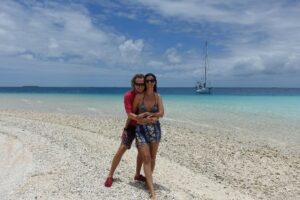

Nationality: Austria
Boat Name: Pitufa
Boat Type/Model and Size: Sparkman & Stephens Huisman 41, aluminium
Your Home Port: Vienna
Blog/website/facebook pages:
How did you start cruising?
We had never sailed before, when we decided that a sailboat was the best way to see the world. We started reading: “How to sail around the world” (Hal Roth) was one of the first tomes we devoured, then “How to choose the right cruising boat” (John Vigor) and a few dozen other books about sailing, cruising, sail trim, storm tactics, boat surveying, diesel engine maintenance, etc. Thus theoretically well prepared, but still without having sailed a mile, we bought our Pitufa, sailed from Mallorca to Croatia in three weeks (just the two of us and our ship’s cat Leeloo) and learned very quickly underway…
We had the boat in Croatia for three years while we were preparing for the cruising life, saving as much for the cruising kitty as we could while upgrading the boat. We were in our early 30s when we gave up our careers and set sail into a new, alternative life-style.
Describe what sort of cruisers you are:
We have been all-year-round full-time cruisers now for 11 years. We kept out apartment in Austria, but have rented it out to have some regular income. Cruising to us means exploring off the beaten track, while working regular jobs aboard our boat. Christian has a PhD in electrical engineering, but now he’s our mechanic, electrician, plumber, carpenter, etc. and he spends most of his free time on the laptop programming. I used to be a highschool teacher, but on Pitufa I’m the helmswoman, seamstress, cook, painter, assistant for whatever project Christian’s doing and additionally I’m a freelance journalist and writer. Boredom is unknown on Pitufa, usually the days are just not long enough to fit all the chores we should do, on top of all the activities we’d like to do.
What type of cruising are you doing currently?
We set out 11 years ago from the Med, via the Atlantic, to our dream destination: the South Pacific. We’ve been cruising here since 2013.
What were the key reasons you selected your current boat?
She’s a very sturdy aluminium construction, reliable in heavy weather and sails well to windward. And she’s a real beauty :-)
What other boats have you owned?
None.
What changes have you made to your current boat?
We added a radar arch to have room for solar panels, installed a watermaker to be independent and a hundred little things to make her a comfy home—repairs, improvements and maintenance are always routine on a cruising boat.


- Adding more solar panels to our boat.
Most useful equipment fitted and reasons for this choice:
- Solar panels (600 W for all our needs)
- Wind generator (for grey days)
- Hydrovane (steers in all conditions without using electricity)
- Gennaker (instead of running the iron genoa)
- Two spinnaker poles (to be able to pole out the genoa flexibly downwind)
- Our Pitufino wifi-gateway (so convenient on passage)
- Watermaker (to be independent)
- An old sturdy sewing machine (for sail repairs and canvas work)
- Pressure cooker (to make preserves as we don’t have a freezer)
- Inverter (to run all our powertools from the batteries)
- Loads and loads of tools and spare parts to be able to fix things ourselves.
Equipment regrets, or things you would do differently:
Can’t think of anything, except that the boat should miraculously grow a metre or two to accommodate all our stuff ;-)


Croatia, Greece, Italy, Spain, Cabo Verde, Suriname, Grenada, Columbia, Panama, Galapagos, French Polynesia, Cook Islands, Tonga, Fiji.
Future cruising plans:
We want to see more little islands in the South Pacific.
List the oceans/seas you have crossed:
Mediterranean, Atlantic, Caribbean, Pacific.
Approximate sea miles:
40,000
Scariest day on the water:
When our wind vane broke on the third day of our Atlantic crossing and the back-up electric autopilot turned out to be dodgy, so we had to hand steer the rest of the way. What seemed impossible during the first scary hours after the failure, turned out to be quite doable, even for a crew of two (the cat wasn’t much help).
Usually we do four hour shifts to give the off-watch enough time for proper, deep sleep, but such long shifts were too tough on the helmsperson. We found that we were exhausted after two hours of steering in rather rough conditions (we were sailing downwind in strong trades around 20 knots), so we shortened the watches. We grew with the challenge and arrived in Suriname quicker than expected–we probably kept the course better than the windvane and eager as we were to arrive had more canvas up than we normally do.
Best cruising moment:
All moments with nature: swimming with sharkies or manta rays, finding a huge bird colony on a deserted island—that’s what makes it all worthwhile. We make quite an effort to get to such special places, anchor precariously on outer reefs and endure rough conditions, just to be close to nature :-)

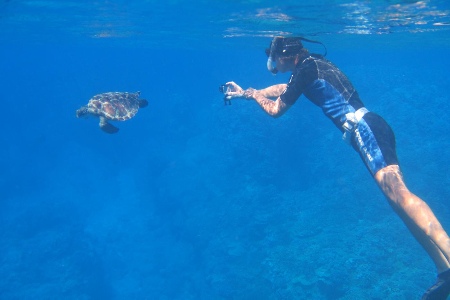
- One of those special moments.
Favourite cruising area and why:
French Polynesia, because the five archipelagos are spread out over an area as big as Europe and therefore have a wide variety of climate zones, landscapes, eco-systems and cultures.
Volcanic islands, atolls, raised atolls—French Polynesia has 116 islands, four distinct languages (and many more dialects) and lots of pristine wildlife gems.
Fiji, because of the wonderfully friendly locals!
Favourite anchorage:
Shh—that one remains a secret ;-)
Favourite cruising apps:
We rely on charts (Garmin, OpenCPN, Navionics) for navigation between islands. Christian has developed a wifi-gateway/multiplexer, the “Pitufino”. This little box is connected to the NMEA bus and makes it possible to use laptop and smartphone as nav instruments, autopilot remote control, anchor watch etc. www.pitufa.at/pitufino.
During nightwatches we can turn off the energy-hungry chartplotter and simply check course, wind, AIS signals, automatic logbook with statistics, etc. on the smart phone while sitting in the cockpit or even on the sofa in the saloon. We have found that close to islands or inside lagoons charts are often not detailed enough or outrightly wrong, so we use satellite images (SAS planet) and a sharp lookout on the bow for piloting.
Favourite cruising websites:
Noonsite. We don’t rely on cruiser’s compendia that are compiled from blogs, as they usually just give a one-day snapshot and generalise. E.g. A spot that one cruiser experienced and recommends as “the good anchorage” happened to be protected in the circumstances they had on that day, but may be uncomfortable or even dangerous in others.
Favourite cruising books:
Hal Roth, Miles and Beryl Smeeton. Reading what those pioneers handled without any gadgets makes everything we face seem harmless in comparison.
What advice or message would you want to pass on to anyone new to cruising or thinking about casting off the dock lines?
Have realistic expectations, cruising doesn’t mean extended holidays. The cruising life can be quite a challenge: technical failures, rough weather, small living space, health issues and you’ll have to manage all those issues on your own.


- Home office on board Pitufa.
Why cruise? In a few sentences, what is it that inspires you to keep cruising?
For us cruising means living close to nature and the elements, a simpler life away from the consumer society—repairing and make-shifting instead of tossing and buying. The freedom to go to those magical places beyond the horizon in the comfy surroundings of our floating home. Spending time with each other and working together as a team.
Any other comments:
We have written a book about our first years cruising (“Sailing Towards the Horizon” available on Amazon) to inspire other would-be cruisers and to keep them from making the same beginner’s mistakes we did.
We used to be horribly naive about passage planning: I remember well how we were sitting on the sofa back home in Austria, planning our first passage on Pitufa from Mallorca (where we bought her) to her new home port in Croatia. We estimated daily runs of 120 nm for this passage across the Mediterranean—little did we know that the fickle winds of the Med have nothing to do with stable trade wind conditions. We also thought we’d reach the Pacific within two years—by the time we arrived in the Cabo Verde Islands after half a year of rushing from port to port we were close to a burn-out and finally realised that we had to slow down in order to enjoy cruising.
We’re “green cruisers”, rely only on alternative energy sources and try to minimize the impact we have on the environment. Lingering in places and returning to them we witness the changes and the negative impact of cruisers as well as local populations on fragile eco-systems.
Whenever we feel that something’s gone awry in a place that we visit we try to take action: Plastic on the beach? We try to raise awareness for pollution and organise a clean-up. Hardly any fish on the reef? We discuss sustainable fishing with the locals.
https://www.pitufa.at/2022/10/no-reef-no-fish-no-fish-no-reef/
Broken coral around the anchorage? We approach cruisers and try to educate about anchoring techniques that avoid damage.
https://www.pitufa.at/2017/05/anchoring-around-coral/
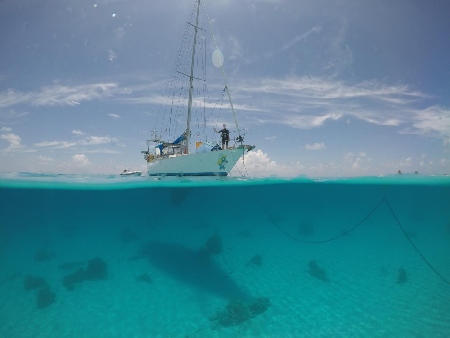


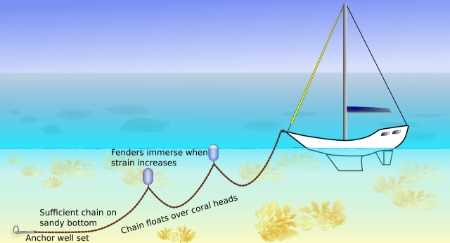
- Our diagram of how to float a chain to protect vulnerable coral
Our projects include two moorings that we installed together with the local community in the main bay of Rapa Iti to protect the coral there and to save cruisers from risking chain and anchor in the deep and tricky anchorage.
https://www.pitufa.at/2019/01/a-mooring-for-rapa-iti/.
https://www.pitufa.at/mooring_gallery/
Whenever we stay longer on an island we visit the local schools and give presentations on pollution, erosion, overfishing—whatever issue seems most pressing.
https://www.pitufa.at/2022/02/eco-presentation-at-school/


- Giving a school presentation to some very interested students.
Quite often we have the impression that we tackle issues that have locals already worried and instead of being offended that we foreigners meddle with their affairs, many seem grateful for our input and appreciate the fact that we care. Sometimes we feel like fighting windmills, but we still think that trying is better than just giving up and leaning back.
We also try to give back to the generous cruiser community by sharing our experiences and recommendations.
We have detailed weather info (e.g. an interactive wind atlas for passage planning https://www.pitufa.at/oceanwinds/) as well as destination guides on our blog https://www.pitufa.at/pitufas-cruising-guides/.
Birgit Hackl and Christian Feldbauer.
SY Pitufa

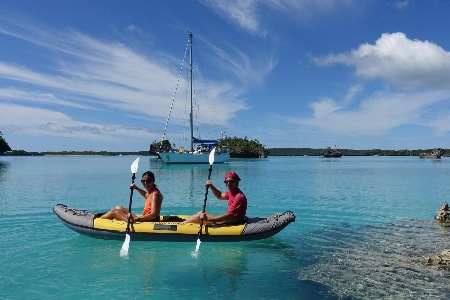
- Human power instead of wind power.
………………………………………………………………………………………………………………………………………..
Related Content:
More Portrait of a Cruiser stories.
If you think you have an interesting story to tell and would like to take part in our Portrait of a Cruiser series, please contact Sue at editor@noonsite.com for a questionnaire.
………………………………………………………………………………………………………………………………………..
The opinions expressed in this article are the author’s own and do not reflect the view of Noonsite.com or World Cruising Club.
………………………………………………………………………………………………………………………………………
Find out all news, reports, links and comments posted on Noonsite, plus cruising information from around the world, by subscribing to our FREE monthly newsletter. Go to https://noonsite.wccstaging.com/newsletter/.
Related to the following Cruising Resources: Atlantic Crossing, Caribbean Sea, Citizen Science, Environment, Pacific Crossing, Portrait of a Cruiser, Routing


